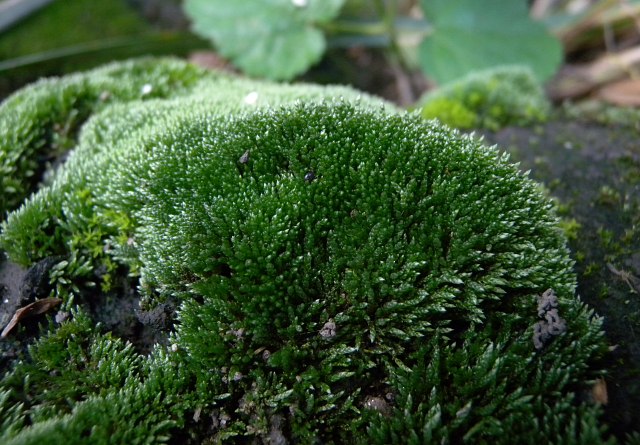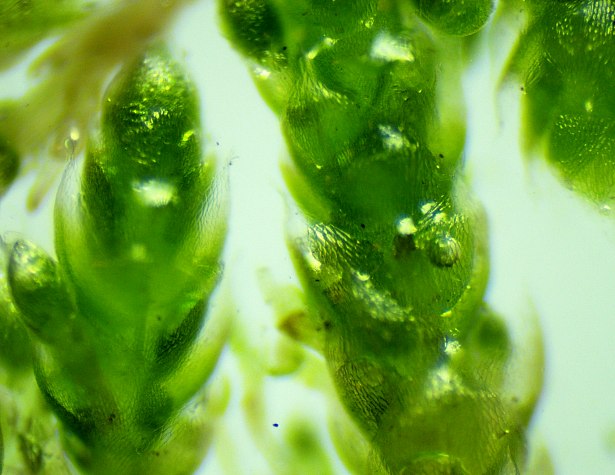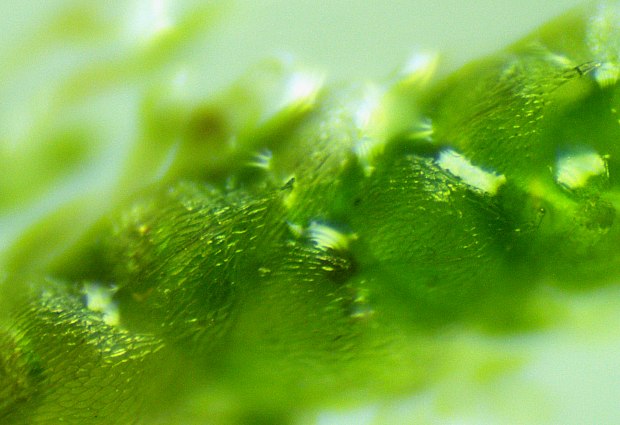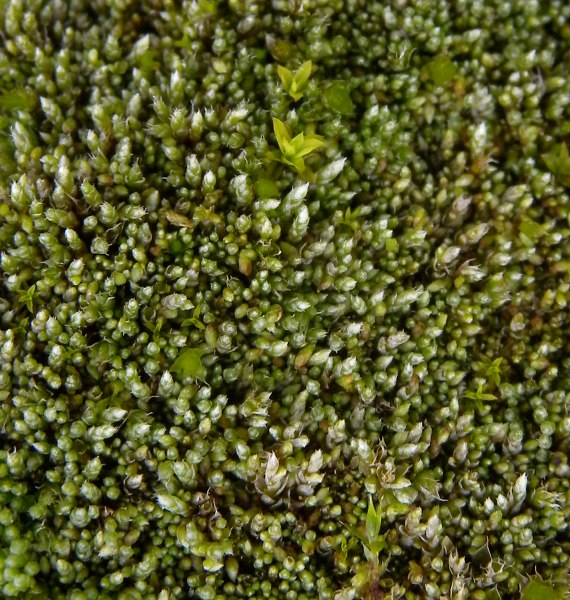
This moss uncommonly produces stalked spore-bearing capsules; this normally happens during the autumn. The slender stalks (setae) of these capsules are terete, hairless, and light green, red, or reddish brown; they are 1-2 cm. long and more or less erect. Mature capsules are 1.5–2.5 mm. long (including their lids), cylindrical-obovoid in shape, hairless, and pink, red, or reddish brown; they droop down from the apices of their stalks. The small lids (opercula) of these capsules have a short-conical dome-like shape. The hoods (calyptrae) cover only the lid and uppermost body of their capsules; the hoods are membranous, strongly beaked, and early-deciduous. After the lid of each capsule falls off, the incurved inner teeth (peristome) are revealed; they regulate the dispersion of spores, which are carried aloft by the wind. Individual spores are 10-15 micrometers across, globoid in shape, and smooth or slightly roughened. The base of this moss is anchored to the substrate by brown fibrous rhizoids. In addition to reproduction by spores, some populations of this moss can spread asexually from bulbils that develop in the leaf axils. As a result of abrasion and wear, pieces of leafy stems can be broken off and spread to new areas, forming new clonal plants under favorable conditions.

Cultivation: The preference is full sun to light shade, moist to dry-mesic conditions, and a substrate consisting of loamy or clay soil, humus, sand, crevices of rocks, crevices between bricks, or gravel. This moss has greater tolerance to dry heat and sunlight than most mosses, but it still prefers a location where some moisture in the substrate is retained. It is also more tolerant of air pollution and ground soil pollution; its foliage can accumulate heavy metals. This is one of the easiest mosses to cultivate if competition from taller plants is absent or reduced.
Range & Habitat: The native Silver Moss is widely distributed in Illinois and it is quite common (see Distribution Map), especially in urban and suburban areas. It probably occurs in every county of the state. This cosmopolitan moss has been found on all continents of the world, including Antarctica. Habitats include borders of sandy woods, thin soil of rocky ledges, partially shaded sandstone slabs and limestone slabs, rocks faces in ravines, shaded boulders in woods, dry sandy areas near lakes, moist sandy ground along springs, ground near the trunks of large deciduous trees, bark of fallen trees along fence rows, gravel between railroad ties, clay embankments along roadsides, ground along alleyways, concrete of old bridges and lake spillways, ground along edges of fields, ground along edges of parking lots, ground along buildings, asphalt roofs, vacant lots in residential areas, crevices of sidewalks, crevices of stone walkways, concrete walls, abandoned concrete driveways, cindery paths and gravelly paths in parks, limestone quarries, coal spoil heaps, cloth bags of dirt along creek banks, and weedy waste ground in urban areas. This moss is found primarily in disturbed urban and suburban areas, although it also occurs in some sandy and rocky natural areas.

Faunal Associations: Very little is known about floral-faunal relationships for this moss. Some oribatid mites have been observed to feed on the protonema of this moss. A protonema is the earliest developmental phase of a moss, consisting of a low mat of fibrous green strands, prior to the develop of leafy stems. Both oribatid mites and some springtails may spread the sperm of this moss to the female reproductive organs, facilitating its fertilization (Cronberg et al., 2006). This moss also provides protective cover for such microanthropods. Pieces of this moss may break off and spread to new areas by clinging to the shoes of people and the feet or hooves of animals.
Photographic Location: Along a north-facing creek bank in Urbana, Illinois, where this moss was growing on cloth bags of dirt; and on ground soil near a parking lot at the webmaster's apartment complex in the same city. Close-up photos were taken indoors using a microscope.

Comments: This is a small, but attractive moss that resembles a soft-textured green pile carpet. It starts out very small and short during the spring, but becomes longer and more luxurious as the year progresses, particularly in locations where it receives some shade and moisture. Through the steady decay of older leafy shoots and rhizoids, it develops a soil that is rich in moisture-retaining humus underneath. Silver Moss (Bryum argenteum) is one of several species in its genus, however it can be distinguished by its diminutive size, compact mass of thread-like leafy stems, and very small leaves with clear translucent tips. This latter characteristic provides it with a silvery or frosted appearance. Silver Moss may have medicinal benefits that have yet to be used. For example, ethanol extracts of this moss are known to have significant anti-bacterial and anti-fungal properties. It has inhibited the growth of such organisms as the bacteria Escheridia coli and Staphylococcus aureus, and the fungus Candida albicans, in the laboratory (Sabovljevic et al., 2006). Another common name of Bryum argenteum is Silver-thread Moss.